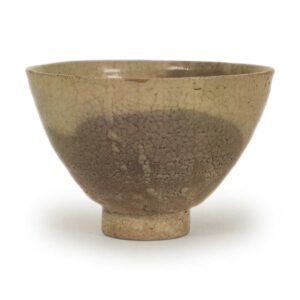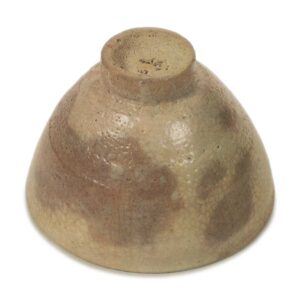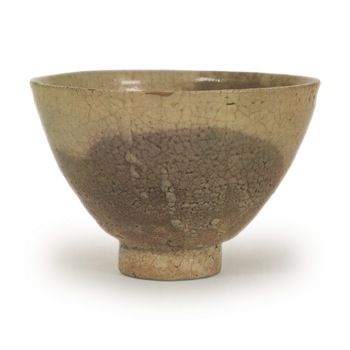

Collection: Fujita Museum of Art
Height: 9.2-9.4cm
Diameter: 13.6cm
Outside diameter of foot ring: 4.6cm
Height of foot ring: 1.6cm
There are two types of Seto Karatsu ware: honte and kiwakete. Kiwakete is a type of flat bowl with a fixed shape and size, and is a type of shaped tea bowl, but honte has no fixed shape or size, except for the clay and glaze.
The name Seto Karatsu is, like Chosen Karatsu and Higo Satsuma, a name given by tea masters for their own convenience, and in this case, although the glaze is of the Seto style (Shino-style), the name comes from the fact that the pottery is made in the Karatsu kilns. This kind of pithy and witty naming is common in the Bunka and Bunsei periods, when the study of tea ceramics was finally beginning to become detailed, and it is probably around this time that the name Seto Karatsu was born. Looking at the calligraphy on the box of this tea bowl, it seems that at first it was written as “Karatsu tea bowl”, and later, after some time had passed, “Seto” was added to the right shoulder, but even from this, it can be understood that the appearance of the name Seto Karatsu belongs to a later period. However, as is clear at a glance, this tea bowl is not made in the Kiwadate style. So-called Honte Seto Karatsu ware has a white, coarse body, and is often covered in a white feldspar glaze that crinkles at the bottom, giving it a plum-blossom-skin (karagi) look. The shape is usually bowl-shaped, but sometimes flat bowls are made, and there are also rare examples of Kumagawa-style bowls, so the dimensions are not fixed. The foot ring is made of clay, and the inside of the bowl has three eyes, which are commonly called “cat’s feet”. Tea masters say that the Honte style is one generation older than the Kiwadate style, and this is a theory that can be understood when looking at the style of the tea bowl, and it is also one of the styles that can be included in the Ko-Karatsu style.
In this respect, this tea bowl is a little different from the regular Honte Seto Karatsu ware. The clay and glaze are both a light tan color, like the old Karatsu ware, and the clay is a little soft, and the glaze is a little runny, but this is probably because the firing was not done properly and the glaze oxidized a little. This is also why there are beautiful light purple raindrops on the inside and outside. The raindrops are extremely attractive when seen through the slightly devitrified, rough-textured glaze, and they could be said to be the life of this teacup. The shape is thin and elegant, with a high foot ring, and the appearance is truly beautiful, with a dignified elegance. The rim retains the marks of a Tenmoku-style bowl, testifying to the fact that it was originally made as a Tenmoku tea bowl, but it is a rare example of a genuine hand-made bowl. The inside of the bowl has the three-eyed (cat’s-paw) feet that are a promise of the bowl, and the leaking rain adds to the tea aesthetic. The foot is made of clay and is thinly made. Inside the foot ring, the creases characteristic of Karatsu ware can be seen, and the crack in the center of the bowl adds to the beauty of the piece. There are four repairs on the rim.
Accessories:
Inner box: paulownia wood, plain finish
Same: inscription on lid: “Seto Karatsu tea bowl”
The history of this piece is unknown.



